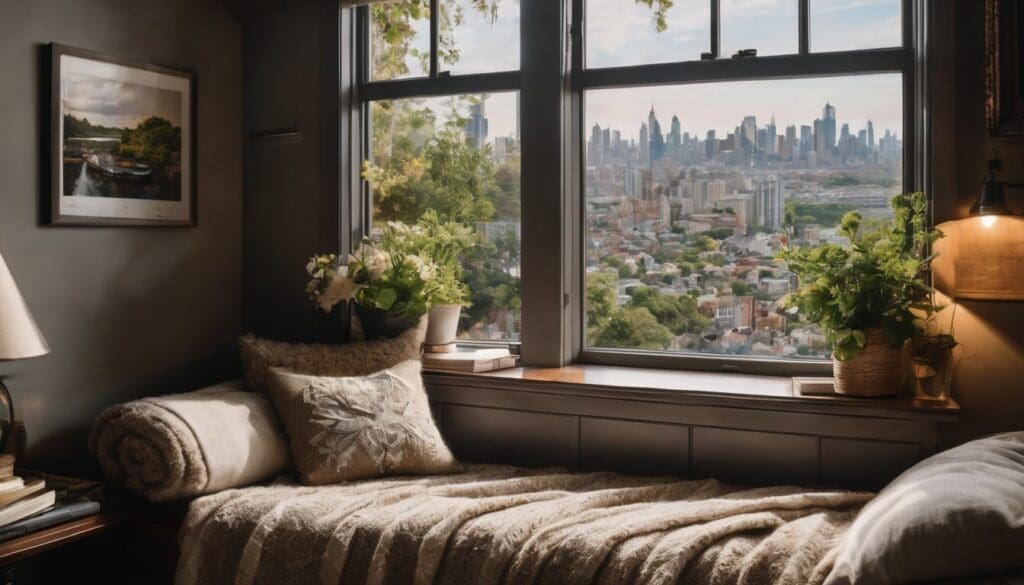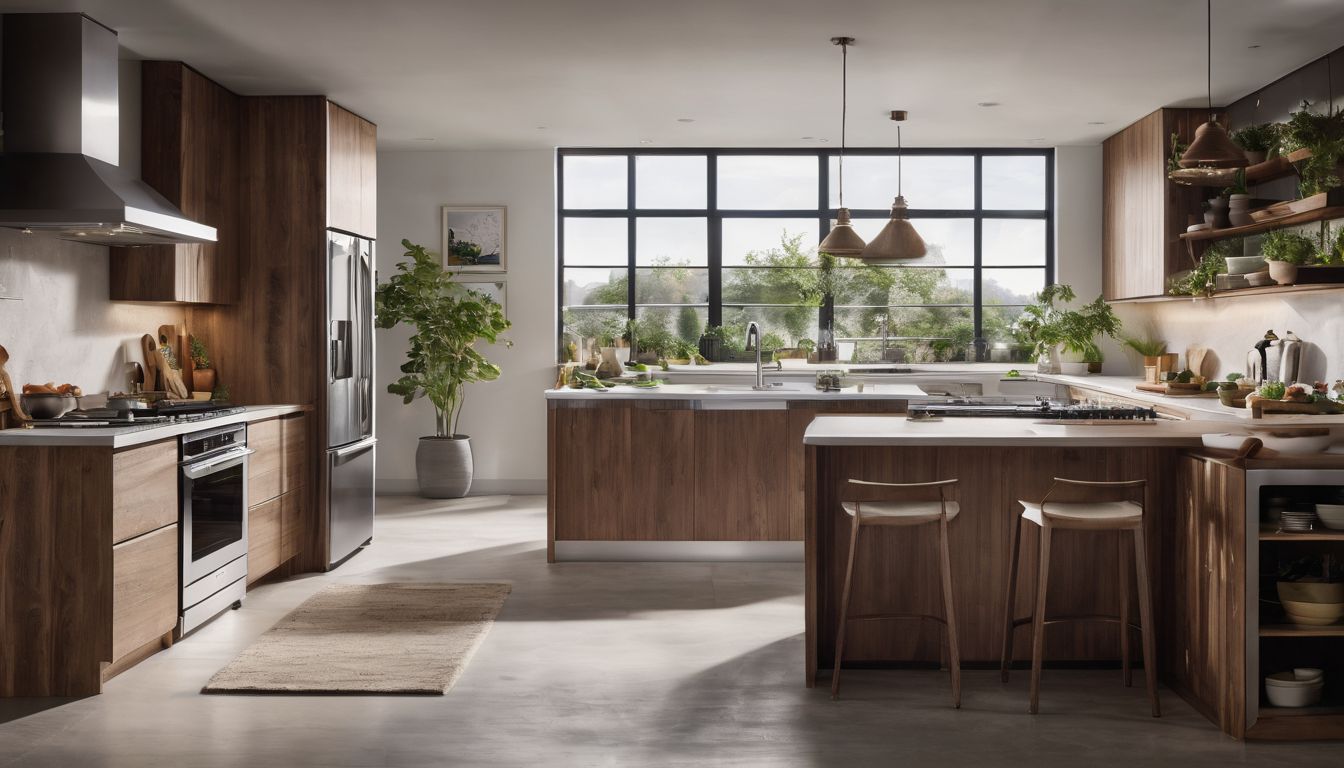Cramped city spaces can leave us yearning for a touch of nature. Biophilic design, the art of bringing the outdoors in, is transforming homes into sanctuaries. Discover how natural light, greenery, and organic materials create harmony in your haven.
Ready to breathe life into your living space?.
Key Takeaways
- Biophilic design merges modern architecture with natural elements, using light, organic materials and greenery to promote wellbeing in home interiors.
- Incorporating plants, living walls, native materials and maximising natural light enhance air quality and create a calming atmosphere for homeowners.
- The integration of biophilic design principles promotes sustainable living by reducing the need for artificial lighting and improving indoor environmental quality.
- Technological advancements are expanding the capabilities of biophilic design within homes through smart systems that manage natural elements more effectively.
- As people seek healthier, more connected living spaces, the trend towards biophilic interior designs is set to grow alongside eco-conscious lifestyle choices.
Understanding Biophilic Design
Biophilic design is about creating a connection to the natural world within our built environments. It focuses on principles that mimic nature, enhancing wellbeing and promoting a sense of calm and tranquillity.
Definition and principles
Biophilic design merges nature with modern architecture, creating living spaces that promote a connection to the natural world. It’s all about bringing the outdoors indoors while fostering health and wellness through design.
This approach to interior decor draws on elements such as sunlight, fresh air, plants, and water features to craft a mood-boosting environment at home.
Key principles of this innovative concept include using natural materials like wood and stone, integrating greenery into every room, and ensuring ample daylight flows throughout the space.
Organic design also plays a significant role; it incorporates patterns and shapes found in nature into furniture layouts and decorative details. These strategies not only enhance wellbeing but also cultivate sustainable living by reducing the need for artificial lighting and promoting cleaner indoor air quality.
Benefits for homeowners
After understanding the definition and principles of biophilic design, homeowners can appreciate the benefits this nature-inspired approach offers. By incorporating natural elements into their interiors, such as using natural light, embracing nature’s colour palette, adding plants and living walls, and utilising natural materials, homeowners can create a calming space that enhances well-being.
This connection to nature in home décor not only brings visual and sensory delight but also contributes to a sustainable lifestyle while promoting eco-friendly living.
In addition to creating a visually appealing environment, integrating biophilic design principles into home interiors can have mood-boosting effects by providing a sense of tranquillity and reducing stress levels.
Incorporating Natural Elements into Home Interiors
Embracing natural light, using nature’s colour palette, and incorporating plants and living walls are essential aspects of biophilic design for home interiors. Additionally, utilising natural materials and embracing natural shapes and forms can create a calming and visually appealing space at home.
Use of natural light
Natural light is a key element in biophilic design, creating a connection between indoor spaces and the outdoors. It fosters a sense of openness and wellbeing by illuminating natural patterns and colours within the home.
Incorporating large windows, skylights, and glass doors allows for ample sunlight to filter through, reducing the need for artificial lighting while providing a mood-boosting ambiance.
The strategic placement of mirrors can also help reflect and maximise natural light throughout different areas of the home.
Embracing nature’s colour palette
Incorporating nature’s colour palette into home interiors brings a sense of calm and connection with the outdoors. By using earthy tones, greens, blues, and browns, homeowners can create a soothing and harmonious environment that reflects the beauty of nature indoors.
These colours can be incorporated through paint, fabrics, furniture, and decorative elements to evoke a natural and serene ambiance in living spaces.
Integrating nature’s colour palette enhances the visual appeal of home interiors while promoting relaxation and tranquillity within the living environment. This approach also aligns with biophilic design principles by fostering a deep connection to nature through the use of natural patterns and hues, contributing to overall wellbeing in the home.
Incorporating plants and living walls
- Introduce a variety of indoor plants such as peace lilies, snake plants, and spider plants to add greenery and improve indoor air quality.
- Consider installing a living wall or vertical garden to create a stunning focal point that connects you with nature right within your living space.
- Utilise hanging planters and wall – mounted pots to bring an abundance of greenery while saving space.
- Select low – maintenance plants to make upkeep easier while still enjoying the benefits of biophilic design.
- Incorporate a mix of different plant sizes, shapes, and textures to create visual interest throughout your home.
Utilising natural materials
In addition to incorporating plants and living walls, biophilic design emphasises the use of natural materials in home interiors. Utilising natural materials such as wood, stone, bamboo, and cork brings a tactile connection to nature into the living space.
These elements not only add an organic touch but also contribute to creating a calming and visually enriching environment. By integrating sustainable and eco-friendly materials into interior design, homeowners can enhance their wellbeing while reducing the environmental impact of their living spaces.
Embracing natural materials in home decor helps create a serene and visually appealing atmosphere that promotes a sense of harmony with nature Keywords: Nature-inspired interior design; Incorporating natural patterns in home decor; Connecting with nature through design; Eco-friendly homes; Wood, stone, bamboo,and cork in interior design; Enhancing well-being through interior design
Incorporating natural shapes and forms
Natural shapes and forms can elevate the aesthetics of a living space, adding an organic feel. Incorporating these elements in home interiors can create a visual connection with nature, promoting a sense of calm and tranquillity.
By integrating natural shapes such as flowing curves or irregular patterns into furniture, decor, or architectural details, homeowners can bring the outdoors indoors. This mindful approach to design enhances wellbeing through interior spaces.
Incorporating natural shapes and forms isn’t just about visual appeal; it’s also about bringing eco-friendly elements into the home. Embracing organic lines in furnishings or architectural features aligns with biophilic principles by evoking an innate connection to nature.
Biophilic Design Trends
Biophilic design trends include a focus on greenery, living walls, the use of native materials, landscape design, and creating Zen spaces for meditation. These trends reflect a growing desire to incorporate nature into home interiors for improved wellbeing.
Focus on greenery
Incorporating greenery into home interiors is a key aspect of biophilic design. By introducing potted plants, hanging gardens, and living walls, homeowners can bring the natural beauty of the outdoors inside.
This not only adds visual appeal but also enhances indoor air quality by oxygenating the space naturally. Additionally, incorporating greenery creates a calming atmosphere and supports mental well-being, as it connects occupants to nature’s soothing presence within their living environment.
Utilising native plant species and natural materials in landscape design further promotes sustainability and conservation efforts in home interiors. The use of eco-friendly planting methods aligns with the ethos of environmentally conscious individuals seeking to incorporate nature-inspired elements while supporting conservation initiatives within their living spaces.
Living walls
Living walls, also known as green walls, are a popular biophilic design trend that brings nature into the home. These vertical gardens create a visual connection with nature and help purify the air indoors.
By incorporating plants directly into the interior architecture, living walls promote a sense of calm and well-being while adding a striking natural feature to the space. The use of native materials in constructing these living walls further enhances their eco-friendly appeal, making them an ideal choice for environmentally conscious individuals seeking to enhance their homes with sustainable design elements.
Bringing living walls into home interiors offers numerous benefits beyond aesthetics. They contribute to creating healthier indoor environments by reducing pollution levels and providing psychological benefits such as stress reduction and improved mood.
Use of native materials
Incorporating native materials in home interiors is a key aspect of biophilic design, catering to environmentally conscious individuals. Using locally sourced wood, stone, and other raw materials not only reduces carbon footprint but also connects the living space to the surrounding environment.
By bringing in natural elements that are indigenous to the area, homeowners can promote conservation and support sustainable practices within their homes. Additionally, integrating native materials into interior design creates a sense of authenticity and uniqueness that resonates with eco-friendly values, enhancing the overall aesthetic appeal while contributing to environmental wellness.
Landscape design
To further enhance the connection between indoor and outdoor spaces, landscape design plays a crucial role in biophilic home interiors. Integrating natural elements such as water features, stone pathways, and sustainable vegetation into the surrounding environment can help create a cohesive and calming space that resonates with nature.
By incorporating native plant species and eco-friendly landscaping practices, homeowners can establish a biodiverse habitat that supports local wildlife while promoting environmental conservation within their home environment.
Leveraging landscape design to establish a natural habitat within the home environment reflects an eco-conscious approach to interior design. Native materials in landscaping not only contribute to the visual appeal of the surroundings but also foster sustainability by reducing water consumption and supporting local ecosystems.
Zen spaces for meditation
Transitioning from landscape design to creating Zen spaces for meditation, biophilic design offers a range of opportunities to incorporate nature-inspired elements into home interiors.
This can include the use of natural materials such as wood and stone, as well as introducing indoor plants and greenery. Creating a dedicated space for mindfulness and tranquillity within the home can involve minimalist furniture arrangements, soft lighting, and neutral colour palettes that evoke a sense of calmness.
Incorporating Zen spaces for meditation in home interiors provides individuals with an opportunity to connect with nature on a deeper level while fostering relaxation and mental wellbeing.
Applications of Biophilic Design
Biophilic design can be applied in various settings including residential spaces, healthcare facilities, and office environments. The incorporation of natural elements in these spaces has been shown to improve overall wellbeing and productivity.
In residential spaces
Ensuring a seamless integration of nature in residential spaces can elevate the overall ambiance. By incorporating natural light, using a nature-inspired colour palette, and introducing plants and living walls, homeowners can create a tranquil and rejuvenating environment.
Furthermore, utilising natural materials such as wood and stone, along with embracing natural shapes and forms in furniture and decor elements, helps to establish a deep connection between the indoors and outdoors within their homes.
Moreover, by integrating biophilic design principles in home interiors, individuals can enhance their wellbeing while fostering an eco-friendly habitat. Each aspect contributes towards creating a mood-boosting space that promotes relaxation, creativity and connection with nature.
Such thoughtful design choices not only bring aesthetic appeal but also foster environmental consciousness within one’s personal living space – promoting sustainable practices at home.
In healthcare facilities
Biophilic design has gained recognition for its ability to enhance wellbeing and promote healing in healthcare facilities. Natural light, plant life, and organic materials are integrated to create a soothing and restorative environment that positively impacts patients, visitors, and medical staff.
The use of nature-inspired elements such as indoor gardens, water features, and calming colour schemes helps reduce stress levels and improve overall wellness. By incorporating biophilic principles into healthcare settings, it’s possible to create spaces that not only support recovery but also offer comfort and tranquillity.
Healthcare facilities benefit from the incorporation of biophilic design through the creation of environments that foster a sense of calmness and connection with nature. Integrating greenery inside hospitals or clinics improves air quality while promoting mental relaxation for patients.
In office settings
Biophilic design in office settings creates a natural and calming environment, boosting productivity and overall well-being. Incorporating elements such as natural light, living walls, and biophilic materials helps to reduce stress levels while increasing focus and creativity.
By embracing nature-inspired interiors in the workspace, employees can experience improved mental clarity and reduced absenteeism due to a healthier work environment.
Natural elements like plants, wood, and stone not only enhance aesthetics but also contribute to better air quality indoors. This approach aligns with the environmentally conscious mindset of modern offices seeking eco-friendly ways to integrate nature into their design.
The Future of Biophilic Design
Technological advancements will continue to play a key role in the future of biophilic design, allowing for more innovative and sustainable solutions. The integration of biophilic design in modern homes will become even more prevalent as people seek to create healthier and more connected living spaces.
Technological advancements
Technological advancements are playing a crucial role in the evolution of biophilic design, making it more accessible and sustainable for modern homes. Innovations in smart home technology have enabled the development of automated systems that regulate natural elements like light, air quality, and temperature, creating an environment that mimics the outdoors seamlessly.
Furthermore, advances in 3D printing and sustainable materials are allowing homeowners to incorporate nature-inspired elements into their interiors without compromising on eco-friendliness or aesthetic appeal.
As biophilic design continues to gain momentum, integrating technologies such as virtual reality and augmented reality will enable individuals to experience the benefits of nature within their homes even more profoundly.
Integration of biophilic design in modern homes
Modern homes are integrating biophilic design principles to create a seamless connection between indoor and outdoor spaces. Natural light is maximised through large windows and skylights, while natural materials like wood and stone bring the outdoors inside.
Greenery in the form of potted plants or living walls adds a touch of nature, promoting a sense of calm and wellbeing. The use of native materials further enhances the connection to nature, creating eco-friendly homes that not only look beautiful but also support environmental conservation efforts.
Incorporating biophilic design in modern homes goes beyond aesthetics; it fosters a healthier environment by reducing stress, improving air quality, and promoting mental clarity. Homeowners can achieve this by creating organic shapes in their furniture design or introducing water features for a soothing ambience.
Conclusion
The rise of biophilic design marks a significant shift towards nature-inspired interiors. People are increasingly recognising the impact of incorporating natural elements in their living spaces.
Biophilic design is not just a trend, but a lifestyle choice that promotes wellbeing and connection to the environment. Its growing popularity reflects an increased awareness about the benefits of creating calming and sustainable homes.
As technology advances, integrating biophilic design into modern homes will continue to revolutionise interior spaces for years to come.
FAQs
1. What is biophilic design in home interiors?
Biophilic design brings the outdoors inside by using natural materials and creating visual connections with nature to make calming spaces that boost mood and wellness.
2. How does incorporating biophilic principles enhance well-being at home?
Using biophilic principles connects people with nature, making living spaces feel more tranquil and rejuvenating which can improve your health and happiness.
3. Can you use eco-friendly elements in biophilic interior design?
Absolutely! Biophilic architecture often involves eco-friendly homes with elements like wood, stone, and plants that reflect a love for nature.
4. What are some ways to create a nature-inspired space at home?
To create a nature-inspired space, incorporate natural light, add plenty of plants, and use materials like bamboo or cork in your decor for a true connection to the environment.
5. Is biophilic interior design just about adding plants to my decor?
No, it’s more than just plants; it’s designing with the essence of nature in mind which includes using colors that mimic natural settings and ensuring there’s ample sunlight or mimicking its effect indoors.





